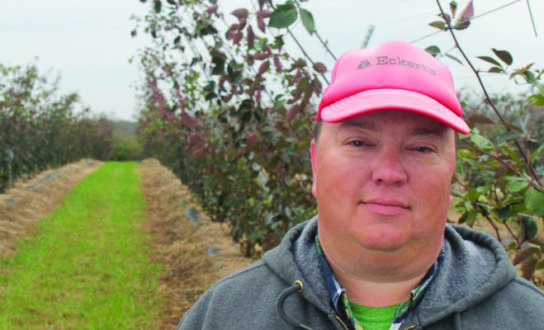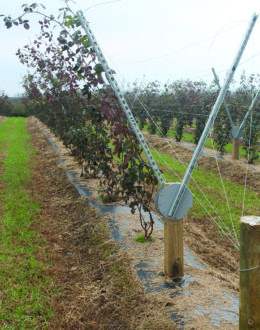

Mar 26, 2019Blackberries’ use separates fruiting, vegetative walls
The old standard two-wire trellis has been replaced on most commercial blackberry farms in Kentucky by newer systems. One of the latest is the swing arm trellis at Eckert’s Boyd Orchard at Versailles, Kentucky. The nine-wire system is a large V with primocanes trained on one side and floricanes trained on the other.
The swing arm trellis system was developed at Eckert’s Orchards at Belleville, Illinois, and was brought to Kentucky with the addition of the Eckert’s Boyd Orchard at Versailles. Eckert’s is a long-established, fruit-growing family based at Belleville.
Trellises do a lot for blackberries. They provide essential support – especially for the vigorous, semi-erect varieties where tip rooting is such an issue. They also control plant size, height, cane spread and productivity, and make pruning and weeding easier. Most importantly, they increase harvest efficiency and make picking more enjoyable for U-pick operations.
The primocane trellis arms are positioned at an angle of roughly 70 degrees from horizontal. A primocane from each plant is trained up from the ground and then horizontally in one direction along the lowest trellis wire. Lateral canes spaced about every six inches are trained up vertically and loosely clipped to the outside of the four trellis wires.
For winter protection from cold winds, the trellis is tilted outward so that it is close to horizontal with the ground. In the spring the trellis arm is rotated up past vertical to the other side of the trellis and the flowering shoots grow upward toward the sun. This positions the floricane side to get the most sunlight for the most growth and to encourage blossoming.
“Blossoms form in the sun,” said Lyle Allen, Eckert’s Boyd Orchard farm manager.
When about 70 percent of the floricanes are blooming, the trellis arm is rotated back to the other side of the trellis at the 70-degree angle. This keeps the vegetative growth in the most sunlight, but lets the berries develop in the shade.
“It gives us a fruiting wall and a vegetative wall,” Allen said. “Berries grown in the shade have better quality.”


While the blackberries are blooming and developing, the new primocanes are trained on the opposite side of the trellis for next year’s crop. The floricane side of each trellis is paired with the floricane side of the next trellis. As the trellis arms are lowered to create a fruiting wall, an overhead arch of blackberries is created. This places ripe blackberries on both sides of the workers who are picking. This makes picking easier and lets workers pick in the shade. It also helps in U-pick operations.
“Consumers really like picking on the trellis. They like picking in the shade and not being out in the hot sun,” said John Strang, fruit specialist in the University of Kentucky’s Horticulture Department.
The trellis system also offers production advantages. Shading the berries means less sun scald. For commercial production, the extra room between the rows and easier access to the berries means harvesting cost is lower.
“Eckert’s estimates a 33 percent lower harvesting cost because the berries are larger and easier to pick,” Strang said. “The swing arms are easy to flip. Two workers can flip a long trellis with no problem.”
The canopy is thinner, which means less disease pressure because the blackberries dry a little faster after a rain or heavy dew. The thinner canopy also means there’s better spray coverage. The faster drying and better spray coverage also mean excellent control of spotted wing drosophila, Strang said. The landscape fabric under the trellis provides excellent weed control although there are some weeds that come up through the holes that have been cut for the canes.
The swing arm trellis system is expensive to build. With nine, high-tensile wires on each trellis, costs can run up to $15,000 per acre. The canes also have to be individually clipped to the wire. This means the labor costs of summer training are high although Eckert’s Boyd Orchard’s clips are reusable.
Occasionally, canes come up beneath the landscape fabric and have to be removed. The posts need to be pressed through holes cut in the fabric during construction – instead of drilling holes – to ensure a tight fit and not leave room for weeds to emerge.
Eckert’s Boyd Orchard grows four thornless blackberry varieties. Natchez is the first variety ready for harvest followed by Ouachita. Triple Crown is ready next with Chester the last to fruit. Both Natchez and Ouachita are erect blackberries. Triple Crown and Chester are semi-erect.
“The erect varieties don’t have the yield of the semi-erect varieties, but they produce earlier extending the blackberry harvest season and they have the sweetness and flavor equivalent to that of the thorny varieties,” Strang said. “That’s what consumers want – a great tasting berry.”
— Dean Peterson, FGN correspondent














